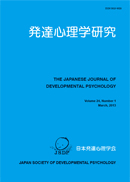Volume 25, Issue 3
Displaying 1-12 of 12 articles from this issue
- |<
- <
- 1
- >
- >|
Articles
-
2014 Volume 25 Issue 3 Pages 207-220
Published: 2014
Released on J-STAGE: September 20, 2016
Download PDF (2018K) -
2014 Volume 25 Issue 3 Pages 221-231
Published: 2014
Released on J-STAGE: September 20, 2016
Download PDF (773K) -
2014 Volume 25 Issue 3 Pages 232-241
Published: 2014
Released on J-STAGE: September 20, 2016
Download PDF (689K) -
2014 Volume 25 Issue 3 Pages 242-250
Published: 2014
Released on J-STAGE: September 20, 2016
Download PDF (739K) -
2014 Volume 25 Issue 3 Pages 251-259
Published: 2014
Released on J-STAGE: September 20, 2016
Download PDF (731K) -
2014 Volume 25 Issue 3 Pages 260-267
Published: 2014
Released on J-STAGE: September 20, 2016
Download PDF (731K) -
2014 Volume 25 Issue 3 Pages 268-278
Published: 2014
Released on J-STAGE: September 20, 2016
Download PDF (711K) -
2014 Volume 25 Issue 3 Pages 279-290
Published: 2014
Released on J-STAGE: September 20, 2016
Download PDF (769K) -
2014 Volume 25 Issue 3 Pages 291-301
Published: 2014
Released on J-STAGE: September 20, 2016
Download PDF (802K) -
2014 Volume 25 Issue 3 Pages 302-312
Published: 2014
Released on J-STAGE: September 20, 2016
Download PDF (702K) -
2014 Volume 25 Issue 3 Pages 313-322
Published: 2014
Released on J-STAGE: September 20, 2016
Download PDF (770K) -
2014 Volume 25 Issue 3 Pages 323-335
Published: 2014
Released on J-STAGE: September 20, 2016
Download PDF (799K)
- |<
- <
- 1
- >
- >|
